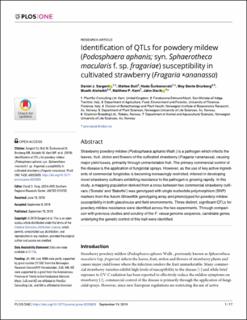| dc.contributor.author | Sargent, Daniel J. | |
| dc.contributor.author | Buti, Matteo | |
| dc.contributor.author | Surbanovski, Nada | |
| dc.contributor.author | Brurberg, May Bente | |
| dc.contributor.author | Alsheikh, Muath K | |
| dc.contributor.author | Kent, Matthew Peter | |
| dc.contributor.author | Davik, Jahn | |
| dc.date.accessioned | 2020-07-09T09:45:56Z | |
| dc.date.available | 2020-07-09T09:45:56Z | |
| dc.date.created | 2019-09-30T08:38:28Z | |
| dc.date.issued | 2019 | |
| dc.identifier.citation | PLOS ONE. 2019, 14 (9). | en_US |
| dc.identifier.issn | 1932-6203 | |
| dc.identifier.uri | https://hdl.handle.net/11250/2661585 | |
| dc.description.abstract | Strawberry powdery mildew (Podosphaera aphanis Wallr.) is a pathogen which infects the leaves, fruit, stolon and flowers of the cultivated strawberry (Fragaria ×ananassa), causing major yield losses, primarily through unmarketable fruit. The primary commercial control of the disease is the application of fungicidal sprays. However, as the use of key active ingredients of commercial fungicides is becoming increasingly restricted, interest in developing novel strawberry cultivars exhibiting resistance to the pathogen is growing rapidly. In this study, a mapping population derived from a cross between two commercial strawberry cultivars (‘Sonata’ and ‘Babette’) was genotyped with single nucleotide polymorphism (SNP) markers from the Axiom iStraw90k genotyping array and phenotyped for powdery mildew susceptibility in both glasshouse and field environments. Three distinct, significant QTLs for powdery mildew resistance were identified across the two experiments. Through comparison with previous studies and scrutiny of the F. vesca genome sequence, candidate genes underlying the genetic control of this trait were identified. | en_US |
| dc.language.iso | eng | en_US |
| dc.rights | Attribution-NonCommercial-NoDerivatives 4.0 Internasjonal | * |
| dc.rights.uri | http://creativecommons.org/licenses/by-nc-nd/4.0/deed.no | * |
| dc.title | Identification of QTLs for powdery mildew (Podosphaera aphanis; syn. Sphaerotheca macularis f. sp. fragariae) susceptibility in cultivated strawberry (Fragaria ×ananassa) | en_US |
| dc.type | Peer reviewed | en_US |
| dc.type | Journal article | en_US |
| dc.description.version | publishedVersion | en_US |
| dc.source.pagenumber | 17 | en_US |
| dc.source.volume | 14 | en_US |
| dc.source.journal | PLOS ONE | en_US |
| dc.source.issue | 9 | en_US |
| dc.identifier.doi | 10.1371/journal.pone.0222829 | |
| dc.identifier.cristin | 1730980 | |
| dc.relation.project | Norges forskningsråd: 217587 | en_US |
| cristin.unitcode | 192,10,2,0 | |
| cristin.unitcode | 192,10,1,0 | |
| cristin.unitname | Institutt for plantevitenskap | |
| cristin.unitname | Institutt for husdyr- og akvakulturvitenskap | |
| cristin.ispublished | true | |
| cristin.fulltext | original | |
| cristin.qualitycode | 1 | |

